There was a lot to see at the CES show last month and I’m finally getting towards the end of my catch-up on some of the things that I saw there and that I haven’t reported on, so far and haven’t seen reported elsewhere. You can find my earlier reports here (Some Display Items That I Saw at CES) and here (CES 2020 Round-Up Part 2).

For the last couple of years, I have been reporting on developments by LetinAR, a Korean start-up that has developed pin mirror technology for AR headsets. The mirrors are very small and as they are close to the eye, they are not visible. However, they can reflect light into the eye. As they are based on mirrors rather than lenses, they don’t suffer from some of the optical disadvantages of lenses. The angle of view depends on the number of mirrors and a couple of years ago, the number was 15.
At CES this year we got an update on progress. The company has grown from nine to 25 people, with 80% in R&D. The company has ‘double digits’ of patents and now has registered its first US patent.
The devices have improved performance with better brightness uniformity and much wider field of view than previous versions and the mirrors are smaller. Vertically, there is almost a 40 deg field of view, where it was previously limited to 23 degrees. Diagonally, the company is achieving 81 deg field of view and 68 deg horizontally.
The company now has an evaluation kit available for glasses-type or goggle-type display systems. It has developed headsets based on a 0.23″ OLED (supplier unnamed) or a 0.74″ OLED from Sony.
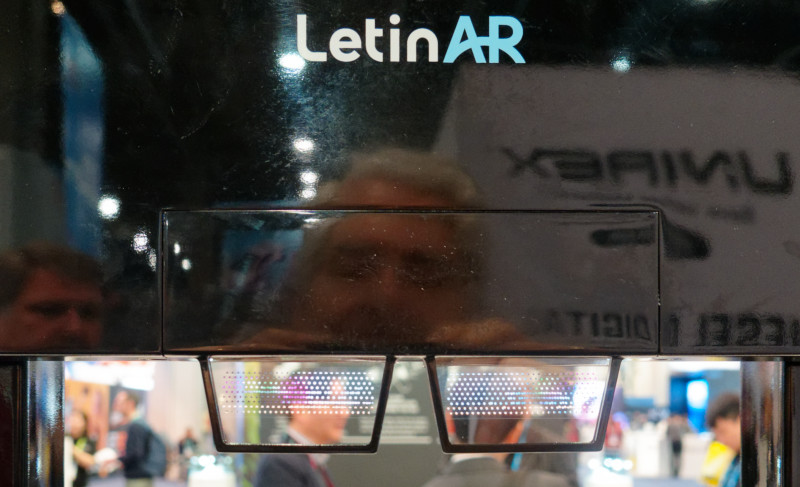 LetinAR has more smaller mirrors, now. Image:Meko
LetinAR has more smaller mirrors, now. Image:Meko
I met up with Tobii in its hotel suite. The company continues to grow and now has 1,100 staff. The company’s gaze technology has been included in more PC products and Dell is a particularly well-established partner over the last three years. The firm has its technology supported in 150 games, now, with many different actions that can be triggered and controlled by gaze. An intriguing development is that the technology has been used to track the way that professional gamers evaluate the display images and players that want to get better can train themselves to more accurately track the kind of eye movements that professionals are using.
Another way that the gaze system is being used is in presence detection. If a known user is in looking at the display, it is shown. If not, it can be blanked or diffused to make it illegible. At the moment this depends on using a Windows Hello camera but is expected to be able to use RGB cameras.
Foveated rendering has also become a key enabler of VR as it allows high enough standalone performance without taking too much GPU and electrical power.
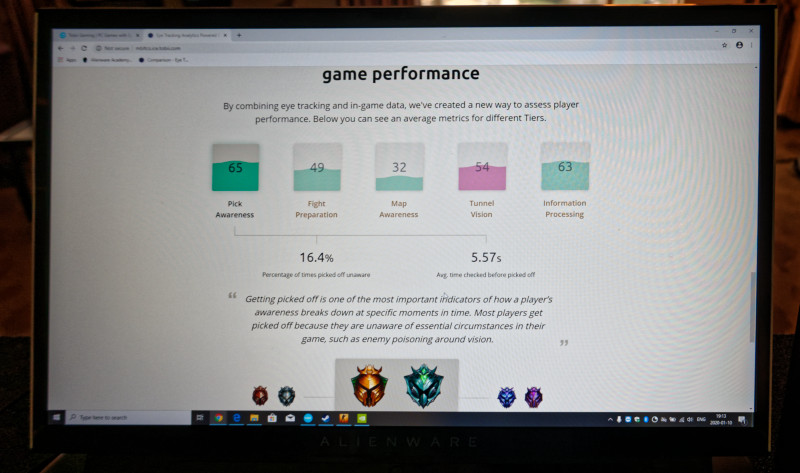 Gamers can work on specific techniques using gaze recognition. Image:Meko
Gamers can work on specific techniques using gaze recognition. Image:Meko
Eureka Park
This year, I spent pretty well a whole day in the Eureka Park and found lots of display-related stories, although I would still have liked more time and was rushing for the last hour or two. There were hundreds of start-ups and small enterprises with lots of interesting things to see.
I have long been keen on the idea of ‘shell’ devices that allow smartphones to be connected to something that looks like a notebook to provide a full keyboard and battery. It would be a great kind of back-up device for me and I have seen many attempts over the years, although most of them have been either too expensive or have struggled with developing a user interface that works on top of Android to provide an interface that works well with a keyboard and mouse. Andromium was one company that was struggling with this, and I was one of those that lost my Kickstarter money when the firm folded before it had shipped a set to me!
In the Eureka Park, we met with Anyware, which has also developed this kind of shell in 12.5″ and 14″ under the ‘PhoneBook’ name. Once again, I have splashed the cash and am optimistic that this time I will actually see a device, although the CoronaVirus supply chain problems seems to have delayed shipment. Hope, as they say, springs eternal!
Anyware was very proud that it has made its system work with iOS devices as well as Android – a capability that it told us is unique.
 Anyware’s PhoneBook is a shell to convert a smartphone. Image:Meko
Anyware’s PhoneBook is a shell to convert a smartphone. Image:Meko
Another topic that I have been watching for a while is the use of Perovskites as alternatives to quantum dots for colour conversion. In the Korean section of the Eureka Park, Seoul National University was showing that it has developed display films based on Perovskites. Unfortunately, although we went back a couple of times, we weren’t able to meet with Professor Tae-Woo Lee, who is behind the development ([email protected]).
 Perovskites can be used as an alternative to QDs. Image:Meko
Perovskites can be used as an alternative to QDs. Image:Meko
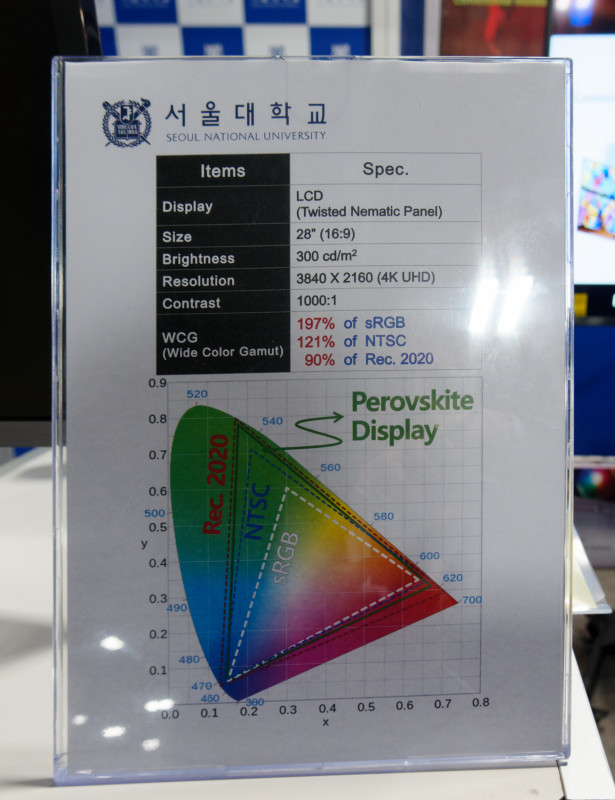
We have seen the HyperVSN and copiers who make spinning LED displays that rely on the persistence of human vision to create images. In the Eureka Park, Kono Corp of Korea had a handheld LED stick that could be used to create images. Applications that the company imagines include the use as an SOS beacon, to warn of automotive hold ups or for messages in crowded places.
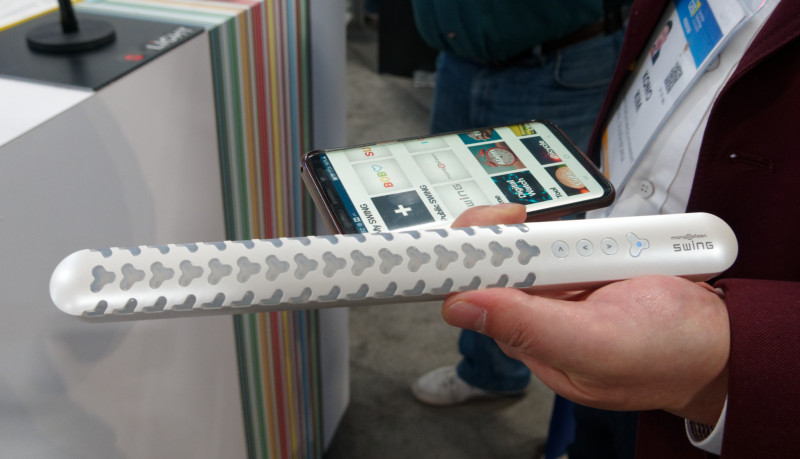 The swing is an LED display designed to be swung or rotated. Image:Meko
The swing is an LED display designed to be swung or rotated. Image:Meko
VTouch of Korea was showing its ‘touchless touch’ technology which can be used to add gesture and touch-style functionality using cameras. The system does some eye tracking to help to predict where areas of interest are. The system can avoid an actual touch – and we had an interesting discussion about the advantages in QSRs, especially in the light of the reports of bacteria on McDonald’s touch systems!
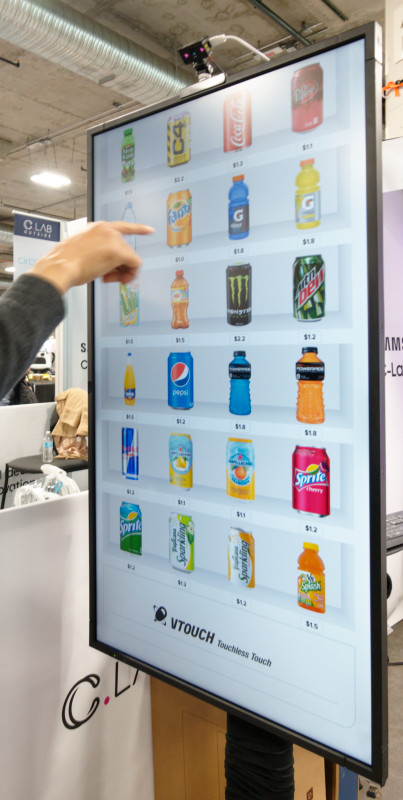 The VTouch ‘touchless’ touch system might be good for QSRs. Image:Meko
The VTouch ‘touchless’ touch system might be good for QSRs. Image:Meko
iBanr.co is a company that has developed what it calls “the world’s first digital Kakemono”. The display is a foldable LED system that can fold down into four pieces for transport or movement in a retail or other environment. The display uses 2mm resin-embedded LEDs (to make the system more robust) and the resolution is 384 x 1024 with 1,600 cd/m2 of output. Cost is around $10K, depending on options.
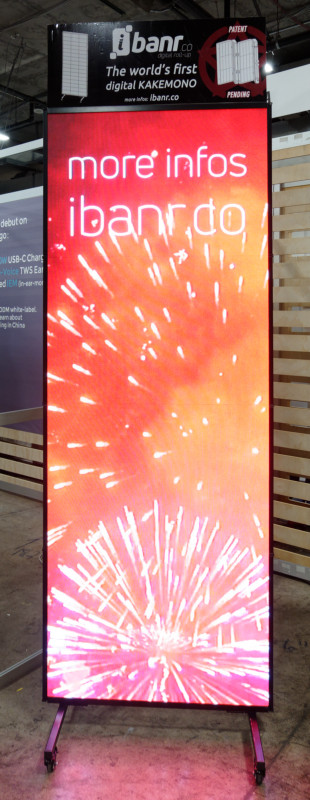 iBanr is a foldable and portable LED sign system. Image:Meko
iBanr is a foldable and portable LED sign system. Image:Meko

